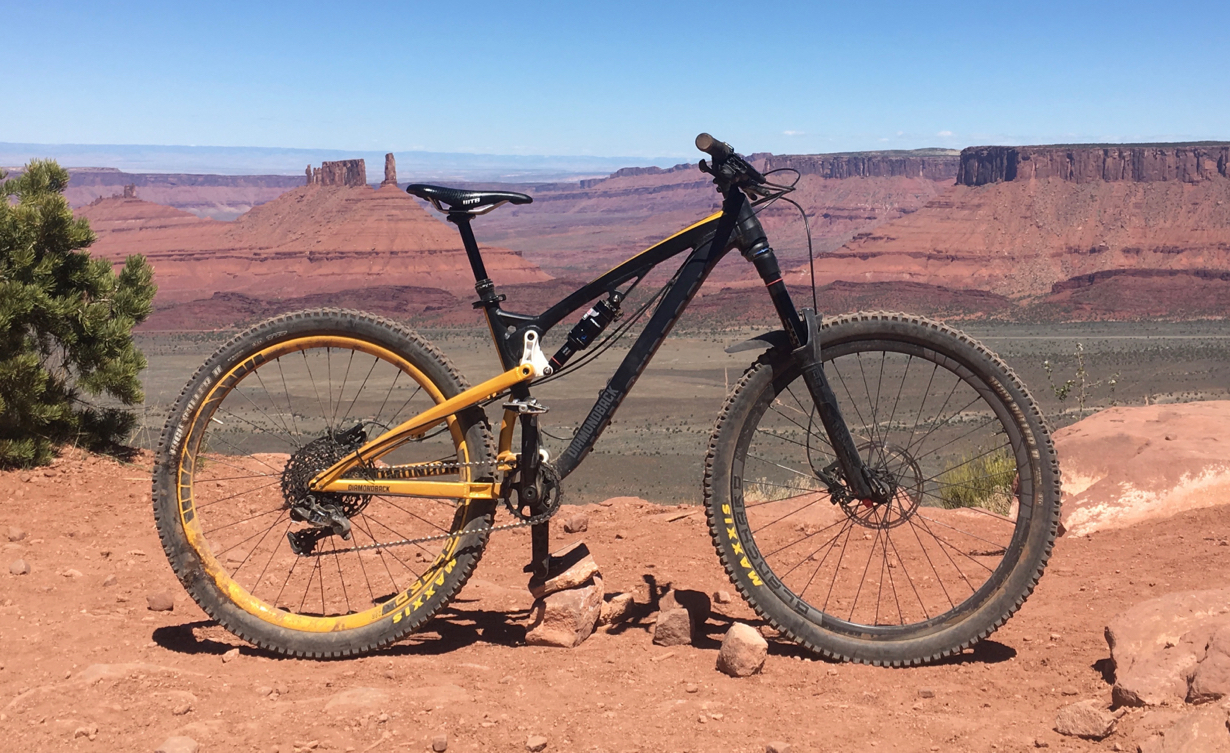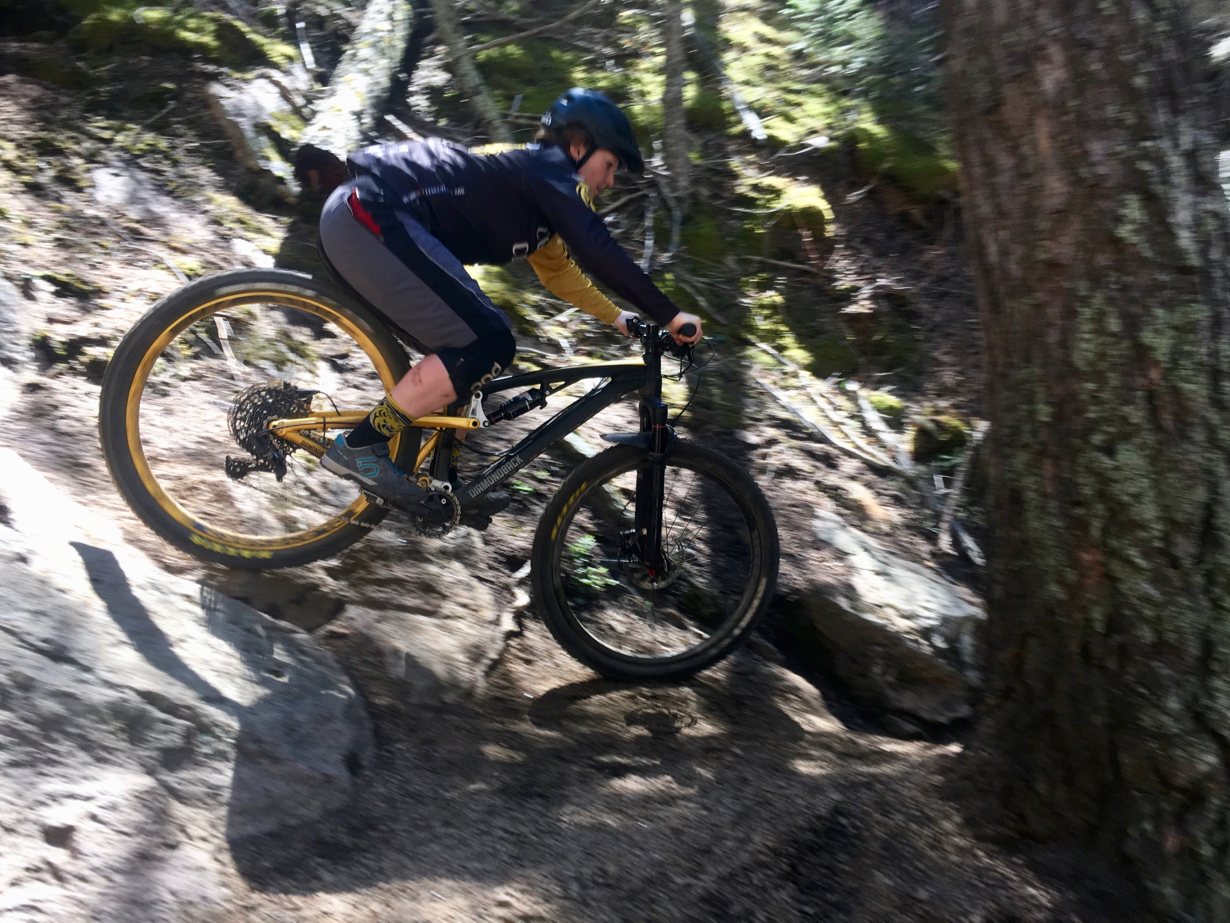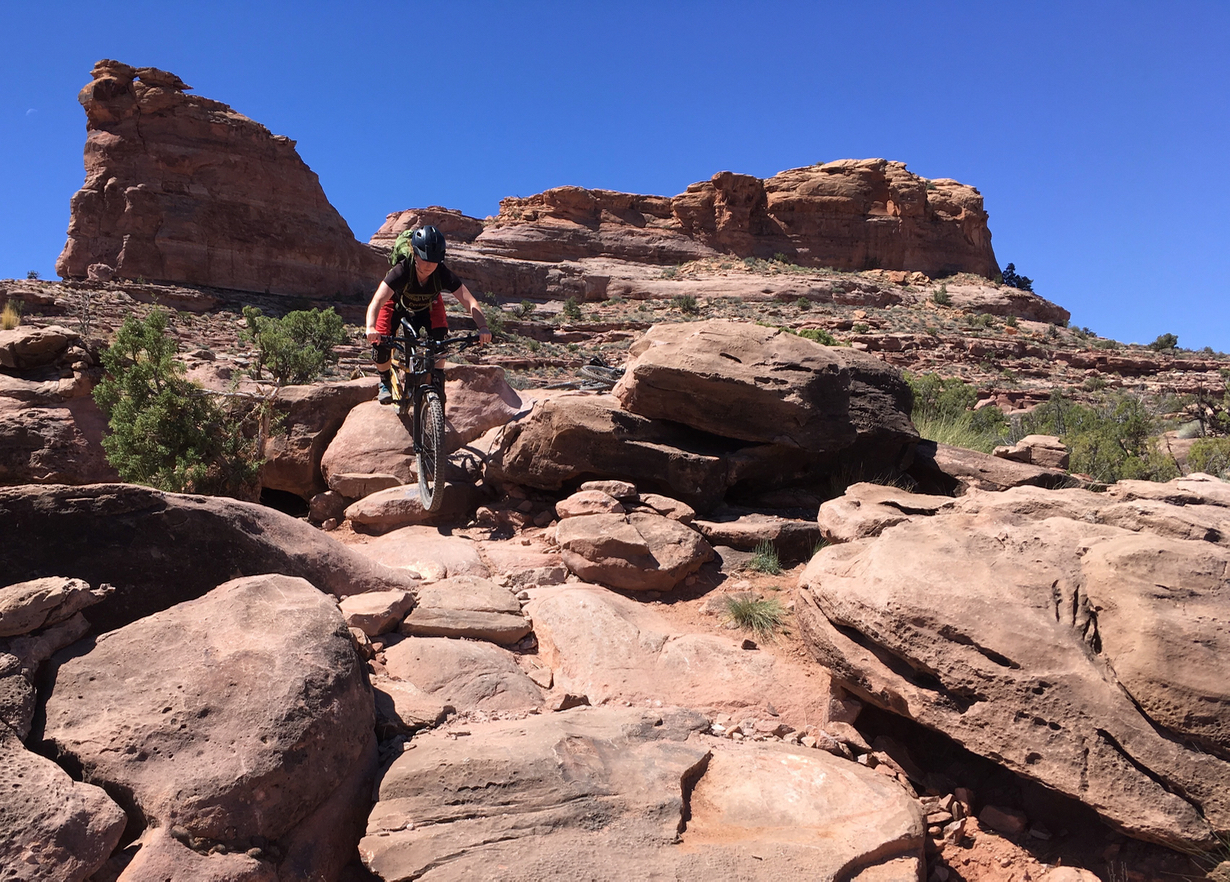2017 Diamondback Clutch 2
Size Tested: Small
Geometry: HERE
Build Overview:
- Drivetrain: Sram GX
- Brakes: Sram Level T
- Fork: Rockshox Pike RC
- Rear Shock: Rockshox Monarch RT3 DebonAir
- Wheels: Diamondback Blanchard
- Seatpost: KS Lev Integra 125mm
- Wheels: 27.5′′
- Travel: 130 mm rear / 150 mm front
Blister’s Measured Weight: 30.9 lbs (14.0 kg) without pedals

Reviewer: 5’2”, 125 lbs.
Test Location: Moab, Utah; Colorado Springs & Grand Junction, CO
Duration of Test: 2 months
MSRP: $4,000
Intro
In the past couple of years, Diamondback has stepped up their game on the performance-bikes front, and many of those bikes are designed around their new Level Link suspension platform.
The Clutch is Diamondback’s women’s all-around trail bike, built to climb efficiently and charge on descents. It has 130 mm of travel paired with a 150 mm fork with a long, low, and slack geometry.
The Clutch is offered in two builds — the Clutch 1 retails for $2800, while the Clutch 2 comes in at $4000.
Diamondback started selling consumer-direct in 2015, and their bikes are available on their website with free shipping. Customers can either have the bike sent to a shop to be built, or delivered directly to their home. When shipping bikes directly, Diamondback includes a small torque wrench that takes the guesswork out of correctly tightening components. A mud guard, flat pedals, shock pump, fork tokens, and spare derailleur hanger are also included.
Frame and Suspension
The Level Link suspension design uses two counter-rotating links, similar to the VPP linkage used by Santa Cruz and Intense. The patent on the VPP suspension design lapsed in 2015, so it’s probably no coincidence that we’re seeing a similar design from Diamondback.
The frame only comes in aluminum, and feels sturdy, though not light. A brace on the non-drive-side rear triangle, Boost spacing, and thick tubing offer a lot of stiffness, giving the feeling that the Clutch will be happy on sideways landings and forceful corners.
Many riders will be happy to see a threaded bottom bracket and ISCG-05 tabs to mount a chainguide. A front derailleur mount is also included with the bike for riders looking to maximize their gear ratio. On a 130 mm bike, it would be nice to have a useable water bottle cage mount, but the only one is on the bottom of the downtube.
All the cable routing is external except for internal dropper seatpost routing in the seat tube. I personally like external routing as it makes it easier to install new cables and swap dropper posts, but it gives the bike a less-than-sleek look. I also found the stock zip ties to break easily, and I had to replace all of them with sturdier counterparts after just a couple rides.
Fit and Geometry
I am 5’2” with relatively short legs. According to Diamondback’s size chart, I am on the tall end of those who should fit the size Extra Small (14”). But after looking at the geometry, I chose to go with the size Small (15”) to get a reach of 406 mm instead of 380 mm. This ended up being a very good call, and I most likely would have felt cramped on the XS.

But I also assumed I would be able to insert the seatpost further into the 394 mm seat tube to accommodate the 125 mm KS Lev Integra dropper. While the seat tube itself isn’t too long, it has a curve in it that prevented me from moving the seatpost as low as I needed to, and I ended up with the seatpost topping out about 6 mm too high for a comfortable pedaling position. This most likely wouldn’t have been a problem with the sizing of the XS. Short riders with proportionately longer upper bodies may need to swap the 125 mm dropper post for a 100 mm to get the seat into the proper pedaling position.
While 130 mm rear travel might have this bike mingling with “trail” bikes, the slack 66° head angle and relatively long 1133 mm wheelbase put the Clutch more in line with many “all mountain’ bikes. The chainstays are kept short at 425 mm for all sizes, which, paired with a moderately progressive suspension design, allows the bike to keep a hint of playfulness with its overall disposition to charge.
The Build
The Clutch 2 is essentially the same as the Diamondback men’s Release 2, with a women’s saddle and a 760mm-wide bar instead of a 780 mm. A size XS is added to the Clutch lineup for riders shorter than 5’3”, and the Clutch also gets a different color scheme than the Release. The Clutch 2’s black, gold, and white palette with mixed wheel colors definitely stands out at the trailhead. For those who’d prefer a less blinged-out look, the men’s Release 2 could be a good choice given its subdued gray color scheme and a price point that for some reason falls $200 below the Clutch.
The Rockshox Pike fork, Monarch DebonAir shock, Sram GX drivetrain (paired with RaceFace Aeffect cranks), and in-house Diamondback cockpit components are all smart choices for this bike. And the 35 mm stem is a nice touch to allow for a comfortable fit while maintaining a long reach.
The in-house aluminum Blanchard wheelset is on the wider side with a 28 mm internal width. It isn’t light, but it feels stiff. Other than weight, the main downside of these rims is that they have an extremely tight fit with tires, causing these to be hands-down the most difficult rims to take tires off and on that I have ever used. I thought that a pair of lightly-used Maxxis High Roller IIs would be easier than the stock Schwalbes, but they still took a lot of effort and the not-so-occasional tire lever.
The biggest problem I have with the build is the Sram Level T brakes. The reach adjust on the Level brakes requires tools, is very hard to access, and can’t be adjusted on the fly. They’re also a bit low on power compared to the Sram Guide and Shimano XT, and I found myself riding more conservatively on steep trails (or sometimes riding faster than I wanted to). On a $4,000 aluminum bike that does not prioritize weight, it would be nice to see something more capable, such as a Sram Guide R or RS.
The stock Schwalbe Hans Dampfs are also a shortcoming of the spec. The tread is aggressive and is a favorite among many riders, but the lower-end “Performance” casing isn’t tubeless-ready, and doesn’t hold up as well as the “Snakeskin” version of the tire. I wasn’t able to get the front tire to set up tubeless, and within three rides, I tore the rear tire on a relatively light hit on a rock. The tires ended up being the only component on the bike that I felt the need to swap almost immediately.
Suspension Setup
I started out riding with 30% sag in the shock, but I found that I’d bottom out on some larger hits. I decreased the sag from 30% to 25%, but that made the bike feel harsh through small bumps.
Bikes with this linkage design have a history of being somewhat fussy to set the suspension on, and the Clutch appears to follow that trend. To improve small bump sensitivity while also improving bottom-out performance, I added some volume reducers in the rear shock and returned to 30% sag. But it seemed like the bike needed a little more support, so I found myself favoring the middle compression setting on the rear shock.
Setting up the suspension for lighter riders can often be difficult, and I found that to achieve proper sag, I ended up only running about 125 psi in the rear shock, which is pretty low. This meant that even fully open, the rebound setting on the shock felt a bit on the slow side. Given that the Clutch is a women’s bike and therefore made for somewhat smaller and lighter riders, it would be good to have a lighter shock tune. And I think some tweaks to the compression tune on the shock could improve its performance for all riders.
I’ve been running the Pike RC at 50 psi without any compression damping, and with 11 out of 20 clicks of rebound damping. After a bit of experimentation, I lowered air pressure to 47 psi and added 1 bottomless token.
Climbing
The Clutch 2 climbs about as well as a 30.9 lb size Small short-travel trail bike should. The suspension is efficient and does not bob up and down while pedaling, even during short out-of-saddle pushes. But the bike is certainly not a feather. The Clutch is stocked with a 30-tooth chainring that helps keep the legs fresh on long and / or steep rides.
Descending
Within my first few rides on the Clutch, I was impressed at how aggressively I was able to ride my favorite trails on a bike that has 35 mm less travel than I am used to. Once I added some volume reducers to the shock, the bike did a good job of retaining small-bump sensitivity while not bottoming out on large hits.

Poppy suspension paired with short chainstays make the Clutch feel a bit more agile than its weight would suggest. Flicking the bike around and popping off lips is fun, but it does take a bit more effort than lighter and steeper bikes of the same travel category, like the Yeti Beti SB5 and the Transition Carbon Scout. Due to its long 1133 mm wheelbase in the size Small, the Clutch is not an overly playful bike.
With a 150 mm fork, riders have a greater margin for error and can keep the front end relatively supple and planted through chunky rocks. But the bike is best suited to aggressive riding — when I don’t drive the bike and instead try to just hang off the back through techy sections, I sometimes get thrown around a bit.
The Clutch performs best when brought up to speed. It feels at home on steep and technical trails, and can hold bumpy lines through rock gardens. The Clutch eats up flat drops impressively well for a 130 mm trail bike, and feels supportive in corners. Compared to the Transition Scout Carbon (which has 125 mm of travel with a 140 mm fork) the Clutch feels a bit more planted and ready to charge, while the Scout feels quick and playful through the same lines.
Durability
The Clutch frame and almost all of the components have held up well to two months of abuse. The paint on the downtube is excessively scratched just from small rocks being flung up by the front wheel, but that’s just cosmetic. The brakes are due for a bleed after two months, which is not unreasonable, but I’ve had better luck with Sram Guide R brakes and continue to think this bike should be spec’d with those.
The Blanchard wheelset has been fairly beaten up. The front rim has a few unproblematic flat spots, while the rear rim is a bit untrue, has many flat spots and has two dents that still allow a tire to seat but constantly spray Stan’s. I have been running my usual tire pressure of 23-27 psi in the front and 26-30 psi in the back in 2.4” Maxxis High Roller IIs, and these rims have suffered much more than a set of (admittedly higher end) DT Swiss E Spline 1900 rims I’ve used that have been ridden on the same trails (and many more).
Bottom Line
The Diamondback Clutch 2 is a mid-travel trail bike that balances the quick and playful aspects of a 130 mm travel bike with a disposition to charge fast down technical trails. Riders who prioritize descending but who want an all-around trail bike that pedals efficiently and is more playful than a full enduro bike should look into the Clutch. The build leaves a little to be desired for the retail price, but the Diamondback Clutch 2 is a fun all-around trail bike with a nice blend of efficiency and slacked-out geometry that make the bike exceptionally capable.
Blister Haiku Bottom Line
The Diamondback Clutch
Climbs fine but descends better
Aggressive good times!
